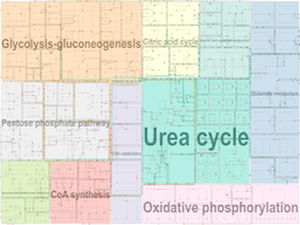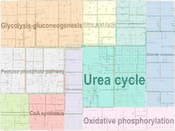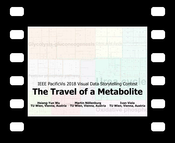Information
- Publication Type: Miscellaneous Publication
- Workgroup(s)/Project(s):
- Date: 2018
- Note: submitted to PacificVis 2018 Data Story Telling Contest
Abstract
Biological pathways are chains of molecule interactions and reactions in biological systems that jointly form complex, hierarchical networks. Although several pathway layout algorithms have been investigated, biologists still prefer to use hand-drawn ones, due to their high visual quality relied on domain knowledge. In this project, we propose a visualization for computing metabolic pathway maps that restrict the grouping structure defined by biologists to rectangles and apply orthogonal-style edge routing to simplify edge orientation. This idea is inspired by concepts from urban planning, where we consider reactions as city blocks and built up roads to connect identical metabolites occurred in multiple categories. We provide a story to present how glucose is broken down to phosphoenolpyruvate to release energy, which is often stored in adenosine triphosphate (ATP) in a human body. Finally, we demonstrate ATP is also utilized to synthesize urea to eliminate the toxic ammonia in our body.Additional Files and Images
Weblinks
BibTeX
@misc{wu-2018-story,
title = "The Travel of a Metabolite",
author = "Hsiang-Yun Wu and Martin N\"{o}llenburg and Ivan Viola",
year = "2018",
abstract = "Biological pathways are chains of molecule interactions and
reactions in biological systems that jointly form complex,
hierarchical networks. Although several pathway layout
algorithms have been investigated, biologists still prefer
to use hand-drawn ones, due to their high visual quality
relied on domain knowledge. In this project, we propose a
visualization for computing metabolic pathway maps that
restrict the grouping structure defined by biologists to
rectangles and apply orthogonal-style edge routing to
simplify edge orientation. This idea is inspired by concepts
from urban planning, where we consider reactions as city
blocks and built up roads to connect identical metabolites
occurred in multiple categories. We provide a story to
present how glucose is broken down to phosphoenolpyruvate to
release energy, which is often stored in adenosine
triphosphate (ATP) in a human body. Finally, we demonstrate
ATP is also utilized to synthesize urea to eliminate the
toxic ammonia in our body.",
month = apr,
note = "submitted to PacificVis 2018 Data Story Telling Contest",
URL = "https://www.cg.tuwien.ac.at/research/publications/2018/wu-2018-story/",
}


 paper
paper video
video

